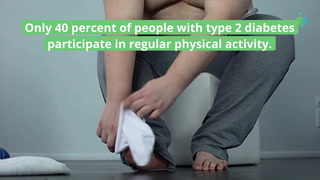Diabetic Neuropathy: 4 Great Exercises for Foot Numbness or Pain

Exercise is vital to living well with diabetes, especially when you manage peripheral neuropathy, or nerve damage, in your feet.
6 Great Exercises for People With Diabetes

Next up video playing in 10 seconds
1. Low-Impact Cardiovascular Exercise
2. Seated Strength Training Exercises
While weight-bearing exercises that keep you on your feet are great for helping you get the most out of every rep, they may not be best if your neuropathy affects your overall balance and stability. Fortunately, there’s plenty of effective strength exercises you can perform from a seated position, Machowsky says.
3. Balance and Stability Work
Try to integrate some sort of balance or stability work into every workout. Perform one-legged exercises (holding onto the wall or a sturdy object for balance), practice walking from heel to toe in a straight line, and complete core exercises, including planks, Dead Bugs, Bird Dogs, and cable chops, says Machowsky.
4. Mind-Body Exercises
Perform your mind-body exercise method of choice in a way that meets your needs and complements your other workouts. For instance, consider a gentle flow yoga class as a way to recover after a more intense strength or cardio workout.
When to Seek Neuropathy Treatment
The Takeaway
- While exercise can feel intimidating with peripheral neuropathy in your feet, it’s one of the best ways to manage and prevent the progression of the condition.
- Low-impact aerobic exercise like walking, stationary biking, and swimming, as well as seated strength training exercises can help improve neuropathy symptoms while minimizing your risk of injury.
- Balance and stability work, as well as active meditation exercises like yoga and tai chi, may also be particularly helpful for your nervous system.
- Seek treatment for peripheral neuropathy if you feel tingling, numbness, loss of sensation, or pain from wearing daily clothing like socks, and keep a close eye on any developing foot blisters or ulcers to avoid further foot health complications.
Resources We Trust
- Mayo Clinic: Diabetes: 4 Steps to Put Your Best Foot Forward
- The Foundation for Peripheral Neuropathy: Staying Active With Peripheral Neuropathy
- American Diabetes Association: Exercising With Diabetes Complications
- Harvard Health Publishing: The Importance of Exercise When You Have Diabetes
- Cleveland Clinic: 5 Best Exercises for People with Diabetes
- Diabetic Neuropathy. Mayo Clinic. June 10, 2025.
- Nguyen V et al. Interventional Effects of Exercise on Neuropathy in Patients With Diabetes: A Systematic Review With Meta-Analysis. BMC Sports Science, Medicine and Rehabilitation. April 14, 2025.
- Propioception. Cleveland Clinic. July 25, 2024.
- Borhade MB et al. Diabetes and Exercise. StatPearls. February 26, 2025.
- Aerobic Exercise: Top 10 Reasons to Get Physical. Mayo Clinic. November 18, 2023.
- Weekly Exercise Targets. American Diabetes Association.
- Olver TD et al. Exercise and Vascular Insulin Sensitivity in Skeletal Muscle and Brain. Exercise Sports Science Review. April 1, 2020.
- Reeves ND et al. Sensory-Motor Mechanisms Increasing Falls Risk in Diabetic Peripheral Neuropathy. Medicina. May 8, 2021.
- Don’t Be the Fall Guy. Harvard Health Publishing. December 1, 2022.
- A Guide to Your Leg Muscles, From the Ground Up. Hospital for Special Surgery. February 8, 2024.
- Bhardwaj P et al. Yoga as a Complementary Therapy in Neuropathic Pain: A Systematic Review and Meta-Analysis of Randomized Controlled Trials. Journal of Family Medicine and Primary Care. October 11, 2023.
- Yang M et al. Tai Chi for Balance and Postural Control in People With Peripheral Neuropathy: A Scoping Review. Complementary Therapies in Medicine. November 2024.
- 9 Benefits of Yoga. Johns Hopkins Medicine.
- Peripheral Neuropathy. Cleveland Clinic. October 14, 2022.
- Diabetes-Related Foot Conditions. Cleveland Clinic. March 21, 2024.
- Peripheral Neuropathy. National Institute of Diabetes and Digestive and Kidney Diseases.

Anna L. Goldman, MD
Medical Reviewer
Anna L. Goldman, MD, is a board-certified endocrinologist. She teaches first year medical students at Harvard Medical School and practices general endocrinology in Boston.
Dr. Goldman attended college at Wesleyan University and then completed her residency at Icahn School of Medicine at Mount Sinai Hospital in New York City, where she was also a chief resident. She moved to Boston to do her fellowship in endocrinology at Brigham and Women's Hospital. She joined the faculty after graduation and served as the associate program director for the fellowship program for a number of years.

K. Aleisha Fetters
Author
K. Aleisha Fetters is a Chicago-based fitness writer and certified strength and conditioning specialist who empowers others to reach their goals using a science-based approach to fitness, nutrition and health. Her work has been featured in various publications including Time, Men's Health, Women’s Health, Runner’s World, Self, O, U.S. News & World Report, and Family Circle. She also creates editorial content and programming for Exos, a sports performance company.
Fetters earned both her bachelor’s and master’s degrees in journalism from the Medill School of Journalism at Northwestern University. She has written multiple books -- Give Yourself MORE, Fitness Hacks for Over 50, My Pocket Guide to Stretching -- and coauthored The Woman’s Guide To Strength Training. She is regularly interviewed as an expert on strength training, women's fitness, and mindset. She works with trainees in person and online.